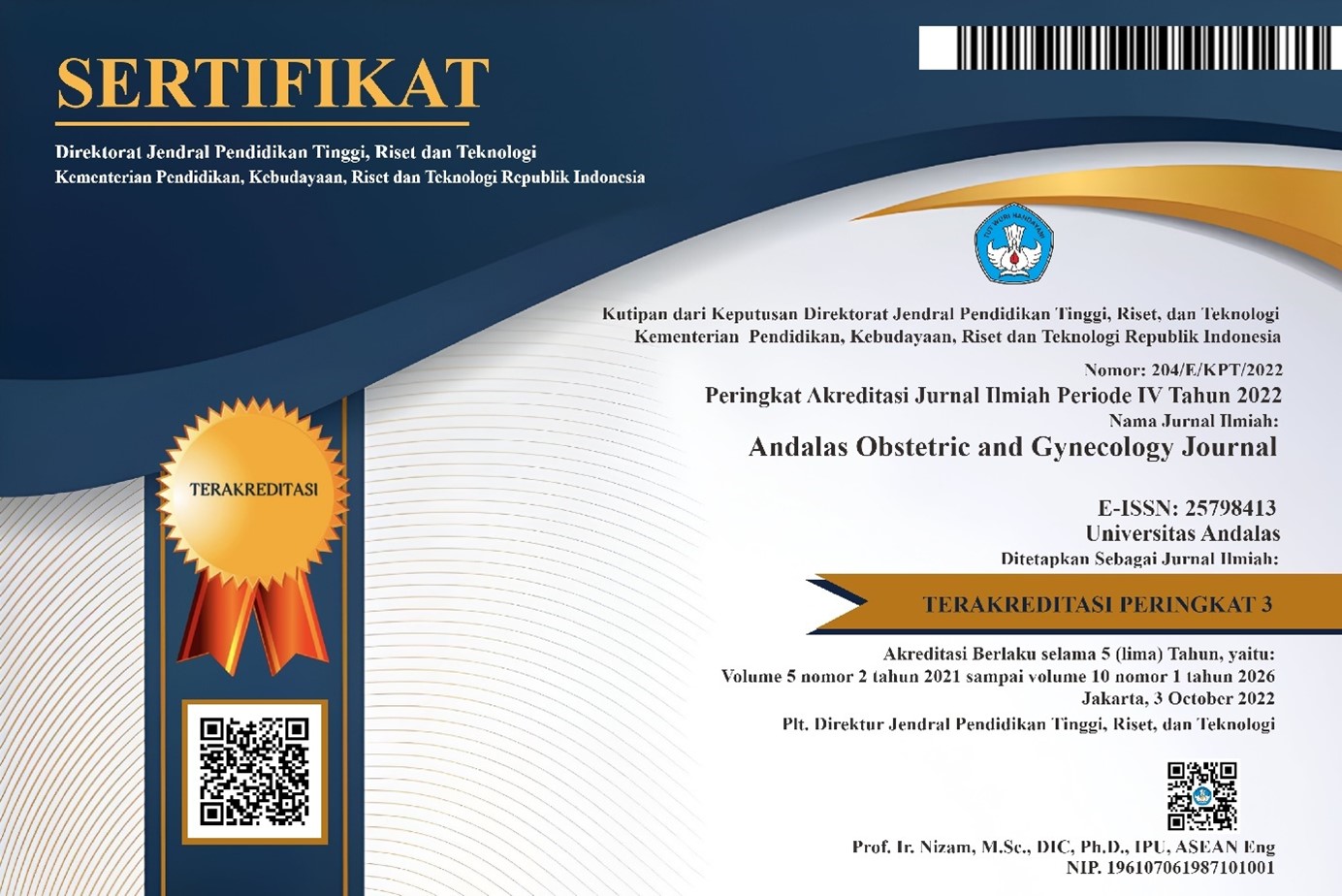The Role Of Vitamin D And Calcium In Pre-Eclampsia And The Association With Neonatal Outcomes
DOI:
https://doi.org/10.25077/aoj.7.1.253-266.2023Keywords:
1, 25 dihydroxy vitamin D3, Calcium, Pre-eclampsia, NeonatalAbstract
Introduction: Pre-eclampsia is one of the main causes of maternal and neonatal death in developing
countries. A low vitamin D level can increase the risk of neonatal abnormalities. Clinical studies
reported various complications of low vitamin D levels, such as pre-eclampsia, gestational diabetes,
low birthweight, and caesarean section. This study aimed to investigate the role of vitamin D in
pregnancy with pre-eclampsia and its association with neonatal outcomes.
Methods: This is an observational analytical study uses a cross-sectional approach to investigate
vitamin D levels and pre-eclampsia, conducted in General Hospital Dr. M. Djamil Padang from Mei
2021 – April 2022. A total of 5 mL blood was withdrawn to analyzed vitamin D. This study has been
approved by Health Research Ethics Committee Andalas University (Approved number:
339/KEPK/2021).
Results: There was a significant difference in the levels of 1,25 dihydroxy vitamin D3 between normal
pregnancy and pre-eclampsia patients (99,18 vs 72,53 pg/ml; p = 0,033). In the pre-eclampsia patients’
first APGAR score, there was a significant difference in the levels of 1,25 dihydroxy vitamin D3 between
normal, moderate, and severe asphyxia groups (114,19 vs 66,75 vs 74,78 pg/ml; p = 0,025).
Conclusion: Measuring early maternal 1,25 dihydroxy vitamin D3 can lower the pre-eclampsia risks
and the impact the perinatal outcomes, particularly in determining first Apgar scores.
References
Achadi EL. Kematian maternal dan neonatal di indonesia. FKM UI pada Rakernas. 2019.
Organization WH. Maternal mortality: key facts. WHO [Internet]. 2019.
Behjat Sasan S, Zandvakili F, Soufizadeh N, Baybordi E. The effects of vitamin D supplement on
prevention of recurrence of preeclampsia in pregnant women with a history of preeclampsia.
Obstetrics and Gynecology International. 2017;2017.
Nassar K, Rachidi W, Janani S, Mkinsi O. Vitamin D and pre-eclampsia. Gynecol Obstet.
;6(6):1-4.
Myatt L, Roberts JM. Preeclampsia: syndrome or disease? Current hypertension reports.
;17(11):1-8.
Wibowo RHKN. Comparison of maternal vitamin D and zinc level between severe preeclampsia
and normal pregnancy in Cipto Mangunkusumo Hospital. Indonesia: Universitas Indonesia; 2014.
Mikhail N. PERBEDAAN KADAR 1, 25 DIHIDROKSI VITAMIN D3 DAN KALSIUM SERUM MATERNAL
ANTARA PREEKLAMSIA AWITAN DINI (PEAD), PREEKLAMSIA AWITAN LAMBAT (PEAL) DAN HAMIL
NORMAL: Universitas Andalas; 2018.
Harli FM. Hubungan Usia Ibu Hamil Berisiko dengan Kejadian Preeklampsia (Studi di Wilayah Kerja
Puskesmas Kabuh, Puskesmas Peterongan dan Puskesmas Cukir Kabupaten Jombang): STIKes
Insan Cendekia Medika Jombang; 2018.
Cunningham FG, Leveno KJ, Bloom SL, Dashe JS, Hoffman BL, Casey BM, et al. Hypertensive
Disorders. Williams Obstetrics, 25e. New York, NY: McGraw-Hill Education; 2018.
Andriani C, Lipoeto NI, Utama BI. Hubungan Indeks Massa Tubuh dengan Kejadian Preeklampsia
di RSUP Dr. M. Djamil Padang. Jurnal Kesehatan Andalas. 2016;5(1).
Lisonkova S, Joseph KS. Incidence of preeclampsia: risk factors and outcomes associated with
early- versus late-onset disease. Am J Obstet Gynecol. 2013;209(6):544.e1-.e12.
Aksornphusitaphong A, Phupong V. Risk factors of early and late onset pre-eclampsia. J Obstet
Gynaecol Res. 2013;39(3):627-31.
Wen Y-H, Yang H-I, Chou H-C, Chen C-Y, Hsieh W-S, Tsou K-I, et al. Association of Maternal
Preeclampsia with Neonatal Respiratory Distress Syndrome in Very-Low-Birth-Weight Infants.
Scientific Reports. 2019;9(1):13212.
Imdad A, Bhutta ZA. Effects of calcium supplementation during pregnancy on maternal, fetal and
birth outcomes. Paediatr Perinat Epidemiol. 2012;26 Suppl 1:138-52.
Hartati N. Preeklampsia dengan Berat Badan Lahir Rendah (BBLR) pada ibu bersalin. Jurnal Gema
Keperawatan. 2018;11(1).
Herzog EM, Eggink AJ, Reijnierse A, Kerkhof MA, de Krijger RR, Roks AJ, et al. Impact of early- and
late-onset preeclampsia on features of placental and newborn vascular health. Placenta.
;49:72-9.
Mihu D, Razvan C, Malutan A, Mihaela C. Evaluation of maternal systemic inflammatory response
in preeclampsia. Taiwan J Obstet Gynecol. 2015;54(2):160-6.
Downloads
Published
Issue
Section
License
Copyright (c) 2023 Tara Fadila, Yusrawati Yusrawati, Hudila Rifa Karmia

This work is licensed under a Creative Commons Attribution 4.0 International License.
Copyright
Authors who publish with this journal agree to the following terms:
- Authors retain the copyright of published articles and grant the journal right of first publication with the work simultaneously licensed under a Creative Commons Attribution 4.0 International License that allows others to share the work with an acknowledgment of the work's authorship and initial publication in this journal.
- Authors are able to enter into separate, additional contractual arrangements for the non-exclusive distribution of the journal's published version of the work (e.g., post it to an institutional repository or publish it in a book), with an acknowledgment of its initial publication in this journal.
- Authors are permitted and encouraged to post their work online (e.g., in institutional repositories or on their website) prior to and during the submission process, as it can lead to productive exchanges, as well as earlier and greater citation of published work (See The Effect of Open Access).
License:
Andalas Obstetrics and Gynecology Journal (AOJ) is published under the terms of the Creative Commons Attribution 4.0 International License. This license permits anyone to copy and redistribute this material in any form or format, compose, modify, and make derivatives of this material for any purpose, including commercial purposes, as long as they credit the author for the original work.







